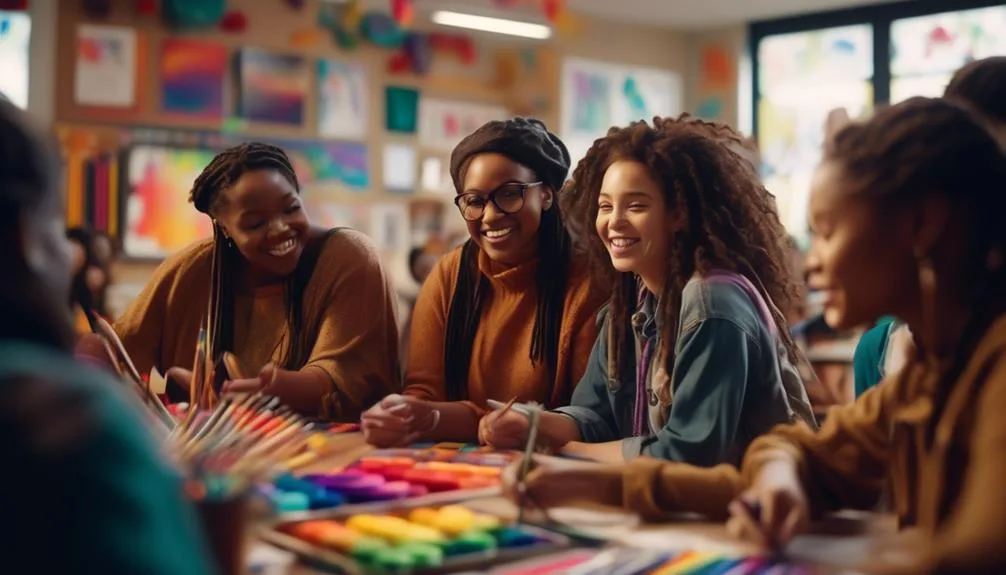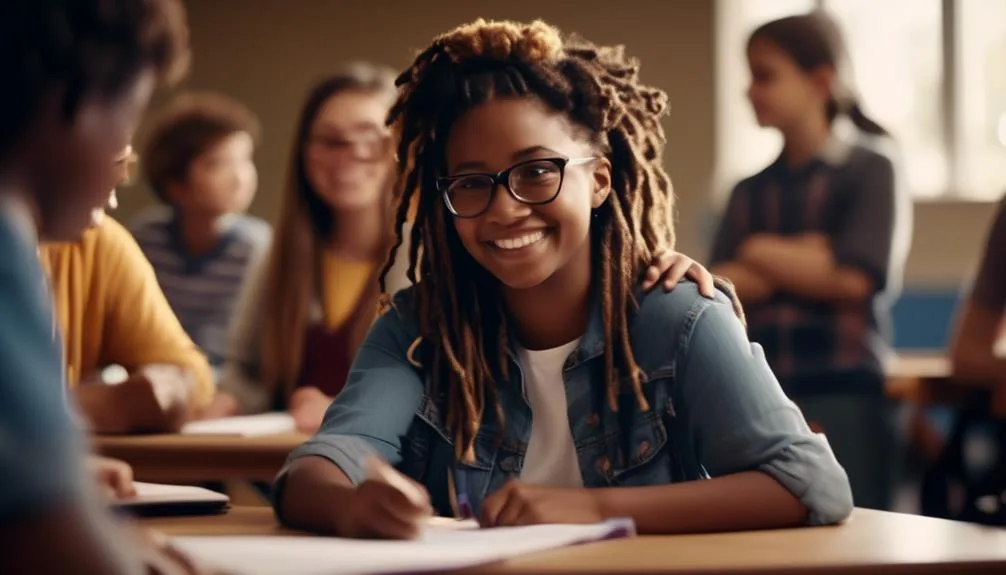Imagine a teacher who, despite facing numerous challenges in the classroom, remains unwavering in their belief in the transformative power of education. This educator radiates positivity, inspires their students to reach their full potential, and creates an environment where everyone feels valued and supported.
But what sets this teacher apart? What are the affirmations they embrace that empower them to make a lasting impact?
In this discussion, we will explore the transformative teacher affirmations that can empower educators like you to become the catalysts of change in your students' lives. So, get ready to uncover the secrets that will unlock your true potential as an empowered educator.
Key Takeaways
- Confidence and belief in one's abilities as a teacher are essential for inspiring students to excel.
- Patience and understanding are key qualities for creating a positive and supportive learning environment.
- Embracing lifelong learning and creativity can enhance teaching and inspire curiosity in students.
- Prioritizing balance, self-care, and gratitude are important for maintaining well-being and effectiveness as a teacher.
Confidence Boosting Affirmations
Boost your confidence as an educator with these empowering teacher affirmations.
Building self-esteem is essential for overcoming self-doubt and becoming a more effective teacher.
Remind yourself that you're a confident and capable teacher, inspiring students to excel.
Trust in your teaching abilities and believe in the power you have to make a difference in your students' lives.
Radiate confidence in the classroom by embodying a positive mindset and embracing challenges as opportunities for growth.
Remember that every setback is a chance to learn and improve.
By repeating these affirmations, you'll strengthen your self-esteem and overcome any doubts that may arise.
Embrace your role as an educator with confidence and watch as your students thrive under your guidance.
Cultivating Patience and Understanding
Cultivating patience and understanding is an essential aspect of being an effective educator, allowing you to create a supportive and empathetic learning environment for your students. By creating a patient classroom environment, you can nurture understanding and empathy in teaching. This means approaching each student with patience and empathy, remaining calm and composed even in challenging moments, and giving students the time they need to learn and grow. It also involves recognizing and validating students' feelings and experiences, listening actively, and showing genuine care for their well-being. Treating each student with kindness and respect is crucial in fostering a supportive and inclusive classroom environment. By practicing empathy and understanding, you can build strong connections with your students and create a safe space for them to thrive.
| Creating a patient classroom environment | Nurturing understanding and empathy in teaching |
|---|---|
| Approach each student with patience and empathy | Recognize and validate students' feelings and experiences |
| Remain calm and composed in challenging moments | Listen actively and show genuine care for students' well-being |
| Give students the time they need to learn and grow | Treat each student with kindness and respect |
| Foster a supportive and inclusive classroom environment | Build strong connections with students |
| Create a safe space for students to thrive |
Fostering Learning and Creativity

To foster a culture of learning and creativity in your classroom, encourage students to explore their interests and think critically. Enhancing student engagement is crucial for creating an environment that promotes active learning.
Encourage students to share their ideas, ask questions, and participate in discussions. This won't only increase their motivation to learn but also foster collaboration and creativity.
Additionally, it's important to encourage innovative teaching methods. Incorporate different instructional strategies such as project-based learning, hands-on activities, and technology integration to keep students engaged and excited about learning.
Prioritizing Balance and Self-Care
To ensure a nurturing and supportive learning environment, it's crucial for educators to prioritize balance and self-care. Teaching can be a demanding profession, and taking care of yourself is essential to being an effective teacher.
Finding work-life balance can be challenging, but it's necessary for your well-being and the well-being of your students. Incorporating self-care practices into your daily routine can help you recharge and prevent burnout. This can include activities such as exercise, meditation, spending time with loved ones, pursuing hobbies, and setting boundaries between work and personal life.
Practicing Gratitude and Appreciation

Practicing gratitude and appreciation is a powerful way for educators to cultivate a positive and uplifting classroom environment. By expressing gratitude in the classroom, you create a sense of warmth and appreciation among your students.
Take the time to acknowledge and appreciate their efforts, achievements, and contributions. Celebrate their growth and progress, whether big or small, and let them know that their hard work is recognized and valued.
When you express gratitude and appreciation, you foster a sense of belonging and motivation within your students, which can lead to increased engagement and a desire for continued growth.
Fueling Success and Motivation
Fuel your success and motivation as an educator by embracing your passion for teaching and inspiring students to excel.
To overcome obstacles in your teaching journey, develop strategies that help you navigate challenges with resilience and determination.
When faced with difficulties, remember that your passion for teaching is the driving force behind your success. It fuels your motivation to excel in the classroom and make a positive impact on your students' lives.
By setting clear goals and working diligently towards them, you can overcome any obstacles that come your way.
Embrace the power of your passion and let it guide you as you navigate the ups and downs of teaching.
With passion as your foundation, success is within your reach.
Building Connections and Relationships

Building connections and relationships is essential for creating a supportive and inclusive classroom environment. It goes beyond simply knowing your students' names; it involves building trust and creating a supportive environment where students feel safe to express themselves and take risks.
To convey a deeper meaning for the audience, consider the following sub-lists:
- Building Trust:
- Consistently demonstrating honesty and integrity
- Being reliable and following through on commitments
- Providing a listening ear and showing empathy towards students' concerns
- Creating a Supportive Environment:
- Encouraging collaboration and teamwork among students
- Celebrating diversity and promoting inclusivity
- Creating opportunities for students to support and uplift one another
- Fostering Positive Teacher-Student Relationships:
- Showing genuine interest in students' lives and experiences
- Providing timely and constructive feedback
- Recognizing and celebrating students' achievements and growth
Developing Resilience and Adaptability
Developing resilience and adaptability is crucial for educators to navigate the ever-changing landscape of education and effectively meet the needs of their students. In the face of challenging situations, it is important to develop resilience and embrace adaptability in the classroom. Resilience allows teachers to bounce back from setbacks and obstacles, learning and growing from failures and mistakes. By maintaining a positive mindset in difficult situations, educators can overcome challenges and continue to provide quality education. Adaptability, on the other hand, enables teachers to adjust their teaching approaches to accommodate unexpected changes and different learning styles. It involves being open to new ideas and feedback from students and colleagues, finding creative solutions to challenges, and embracing flexibility in lesson planning. Developing resilience and adaptability empowers educators to thrive in the dynamic field of education and have a lasting impact on their students' lives.
| Developing Resilience in Challenging Situations | Embracing Adaptability in the Classroom |
|---|---|
| Bouncing back from setbacks and obstacles | Adjusting teaching approaches |
| Learning and growing from failures and mistakes | Accommodating unexpected changes |
| Maintaining a positive mindset | Being open to new ideas and feedback |
| Overcoming challenges | Finding creative solutions |
| Thriving in a dynamic field of education | Embracing flexibility in lesson planning |
Frequently Asked Questions
How Can Affirmations for Empowered Educators Help Improve Classroom Management?
Affirmations for empowered educators can improve classroom management by instilling confidence, patience, and resilience. They promote a positive mindset, effective communication, and the ability to adapt. By reinforcing these qualities, educators can create a more harmonious and productive learning environment.
What Are Some Specific Strategies for Cultivating Patience and Understanding as a Teacher?
Cultivating patience and understanding as a teacher can be achieved through active listening, empathy, and practicing mindfulness. By being present, acknowledging students' emotions, and adapting teaching approaches, you create a supportive and inclusive learning environment.
How Can Teachers Incorporate Creativity Into Their Lesson Planning to Enhance Student Engagement?
To enhance student engagement, incorporate creativity into your lesson planning. Infuse innovative teaching methods, incorporate arts and technology, and encourage critical thinking and self-expression. Inspire curiosity and a love for learning through creative approaches.
What Are Some Practical Tips for Prioritizing Self-Care and Maintaining a Healthy Work-Life Balance as an Educator?
To prioritize self-care and maintain work-life balance, remember that you're not a superhero. Set boundaries, create a schedule, delegate tasks, and make time for relaxation. Take care of yourself so you can be the best educator you can be.
How Can Practicing Gratitude and Appreciation as a Teacher Positively Impact the Overall Classroom Environment?
Practicing gratitude and appreciation as a teacher positively impacts the overall classroom environment by fostering a sense of community and promoting a positive mindset. Modeling gratitude and using gratitude journals can be powerful tools in creating a positive classroom atmosphere.
Conclusion
Incorporating transformative teacher affirmations into your daily routine can have a profound impact on your teaching journey. Studies have shown that practicing positive affirmations can increase self-confidence and improve overall well-being.
In fact, a study conducted by the University of Pennsylvania found that individuals who regularly practiced affirmations experienced higher levels of self-esteem and lower levels of stress.
By embracing these affirmations and empowering yourself, you can create a transformative and lasting impact on your students' lives.

